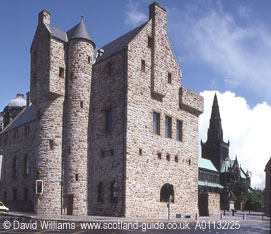1989-92, Ian Begg
The St Mungo Museum of Religious Life and Art is one of the city`s most interesting museums and it also functions as a visitor centre for the neighbouring Glasgow Cathedral. It is housed in a modern building in Scots Baronial style and its design has caused much heated debate over whether it should have been built in this or a more modern style. The museum is named after St Mungo, the city`s patron saint. This remarkable museum deals with various religious philosophies and uses the city`s art collections to illustrate these themes.
The first gallery on the first floor contains religious works of art, some of them quite outstanding. The windows in this gallery are used to display various stained-glass panels, a number of which are from former Glasgow churches built around the turn of the nineteenth century; other panels date back to the fourteenth or fifteenth centuries and were collected by Sir William Burrell. The next gallery on this floor deals with religious life and contains a bewildering array of artefacts used by people of various beliefs while celebrating rites of passage or during festivals.
The top floor gallery deals with the history of religion in Glasgow and the West of Scotland. The displays cover a considerable period of time and the artefacts include very old items such as a Roman altar found near the Antonine Wall. Many of the more modern objects are items used in ceremonies or mementoes of the campaigns of religious organizations such as the temperance movement.
This article is based
on the guidebook "The
Glasgow Guide".

The museum`s bright stonework contrasts sharply with the soot-blackened cathedral behind it.
The museum`s
Zen Garden, Where we are (1993) by Yasutaro Tanaka, stands
behind the building. Its raked gravel bed and undulating mossy `islands`
are punctuated by large boulders. Zen gardens are full of Buddhist symbolism
and are designed according to strict rules. In essence, their traditional
simplicity and use of natural materials helps the uncluttered mind to
contemplate.
Further details about the building can be found in "The Glasgow Guide".